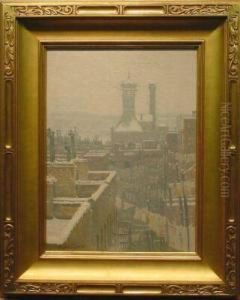George Frederick Muendel Paintings
George Frederick Muendel was an American artist known for his pastoral landscape paintings. Born in 1861 in New York, Muendel developed an early interest in art and pursued his passion through formal education and training.
Muendel studied at the National Academy of Design in New York and also spent time in Europe, where he was influenced by the Barbizon school of painting, a French movement that emphasized tonal qualities, mood, and the harmonious relationship between nature and the painter. He was particularly influenced by the works of Jean-Baptiste-Camille Corot, one of the leading figures of the Barbizon school.
Throughout his career, Muendel strived to capture the serene beauty of the American countryside, often focusing on the Hudson River Valley, which was renowned for its picturesque landscapes and had a rich tradition of inspiring American artists, including those from the Hudson River School. His works are characterized by their tranquil scenes, soft color palette, and the skillful use of light and shadow to evoke a sense of peacefulness and timelessness.
Muendel was a member of various art organizations, including the Salmagundi Club, and his work was frequently exhibited in galleries and institutions during his lifetime. His paintings were well received by critics and the public alike, and he contributed to the tradition of American landscape painting at a time when the country was experiencing rapid change and modernization.
George Frederick Muendel passed away in 1938, leaving behind a legacy of artwork that continues to be appreciated for its quiet beauty and its representation of the American landscape during the turn of the 20th century. His paintings can be found in private collections and occasionally on display in museums that feature American art from this period.

